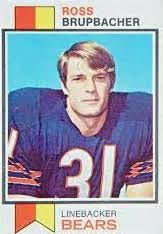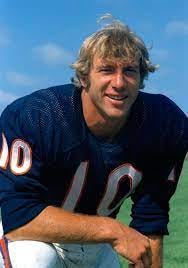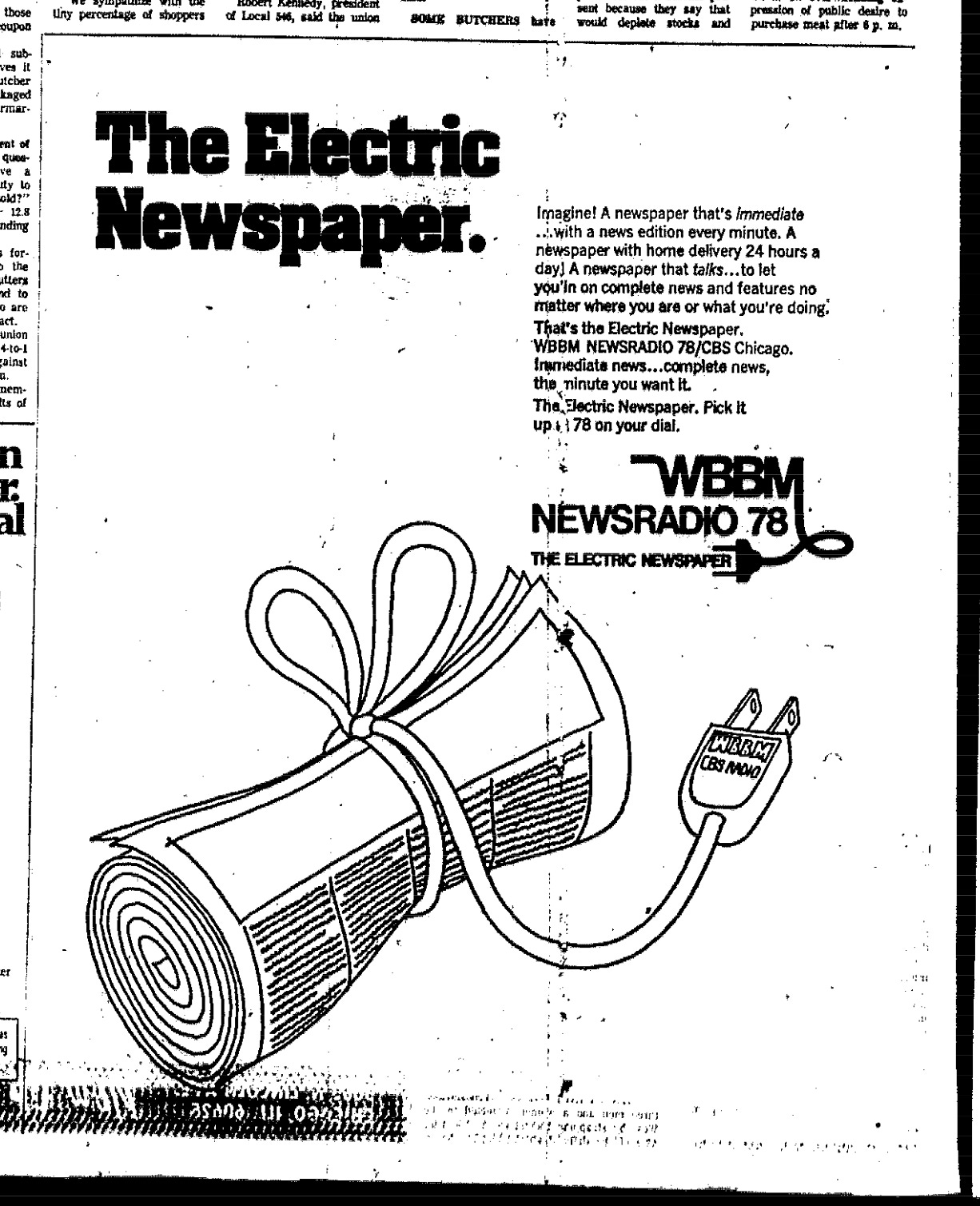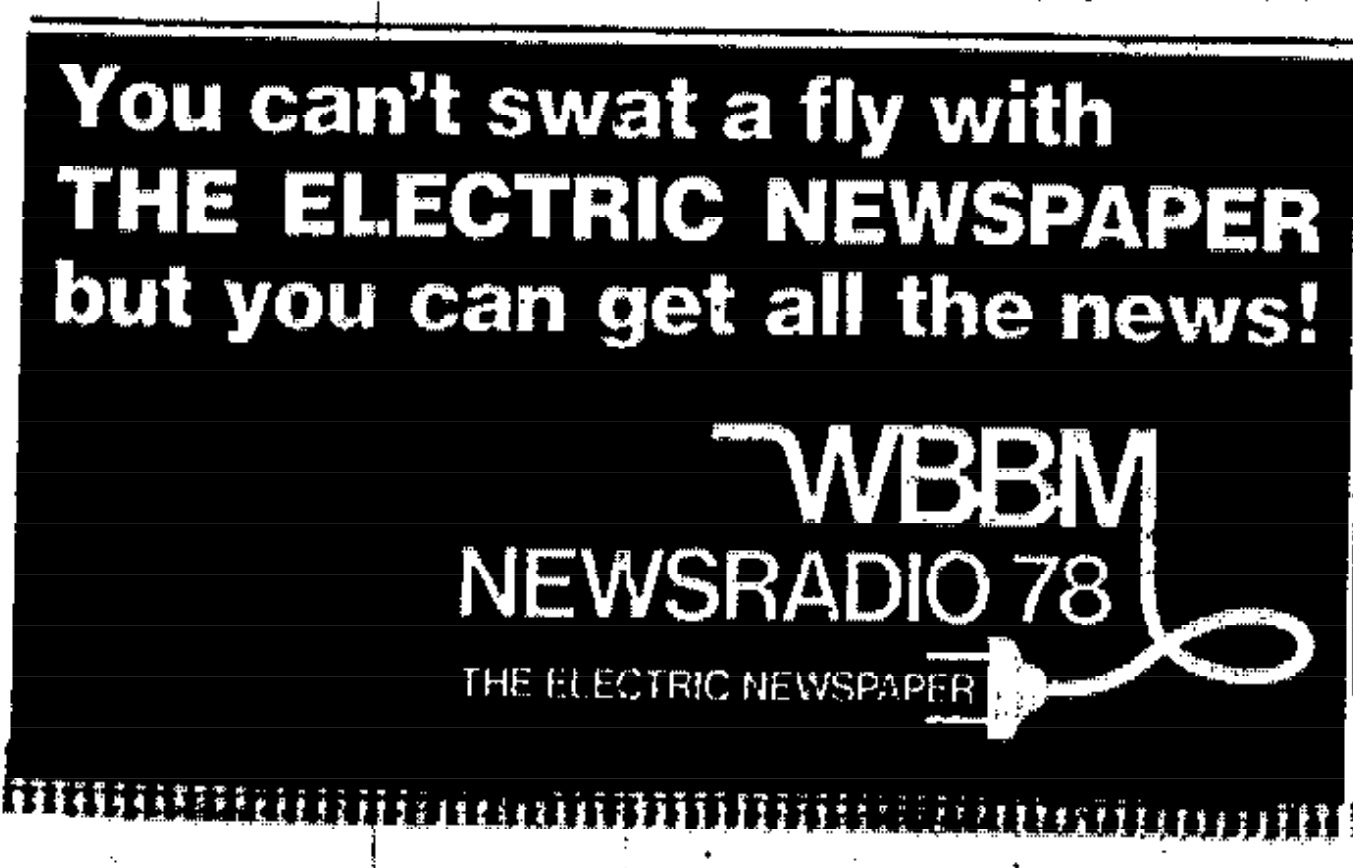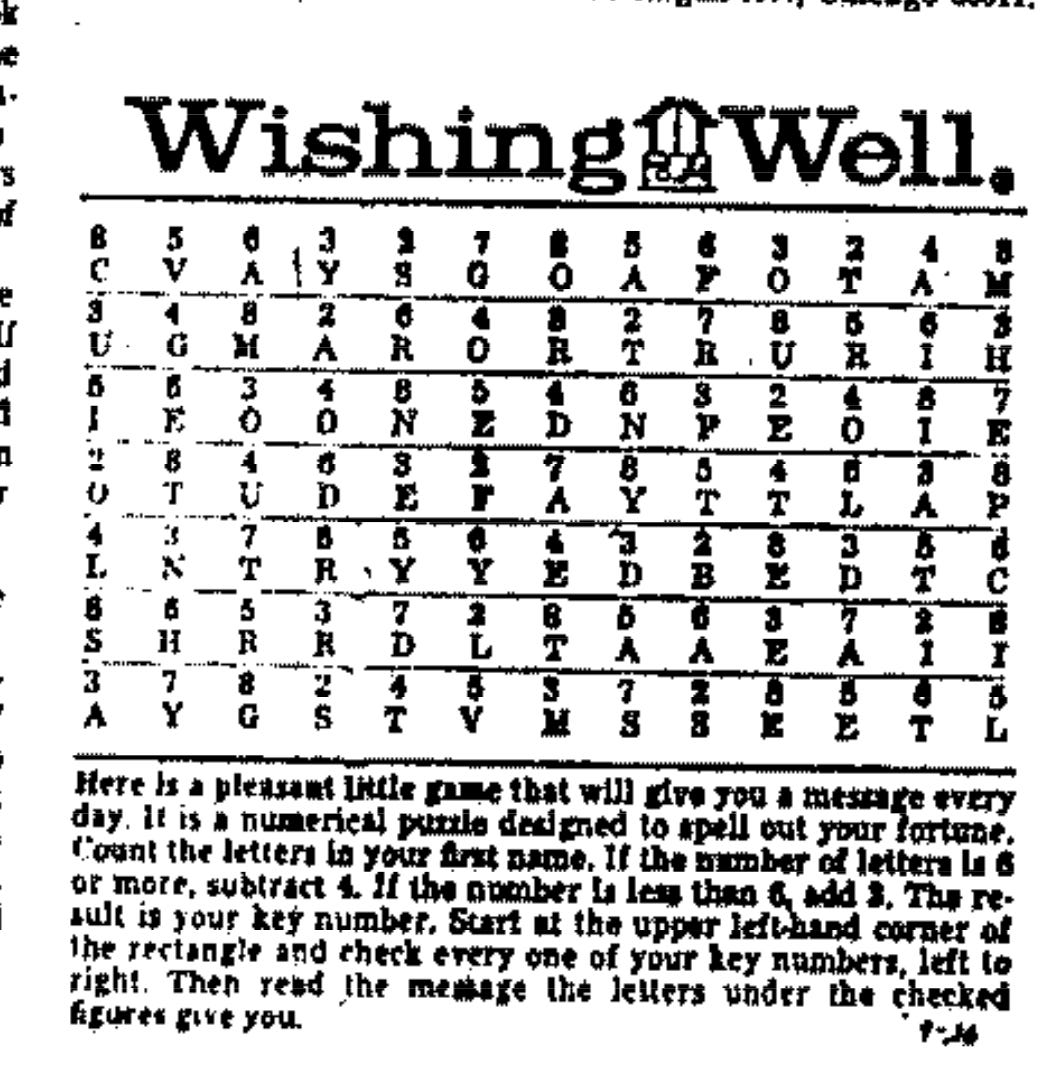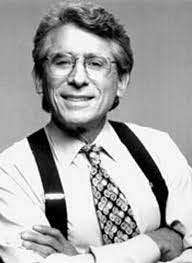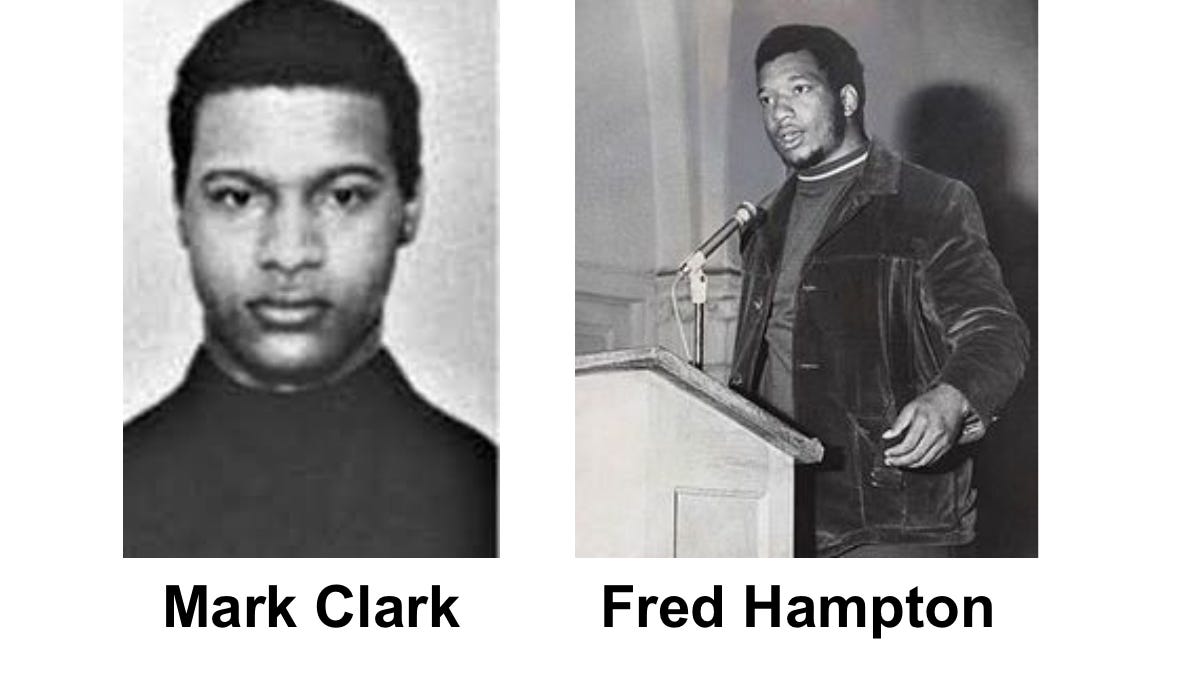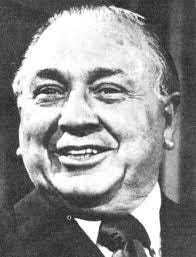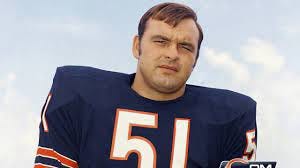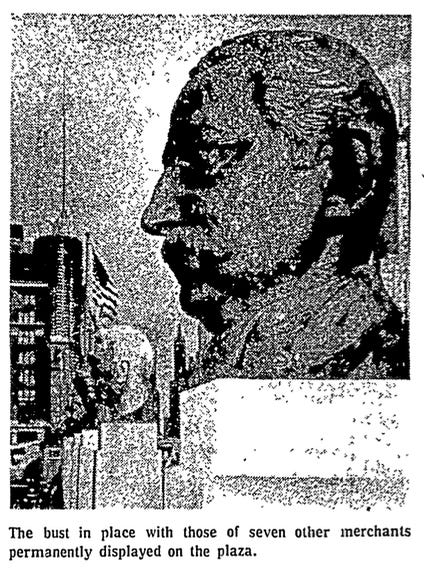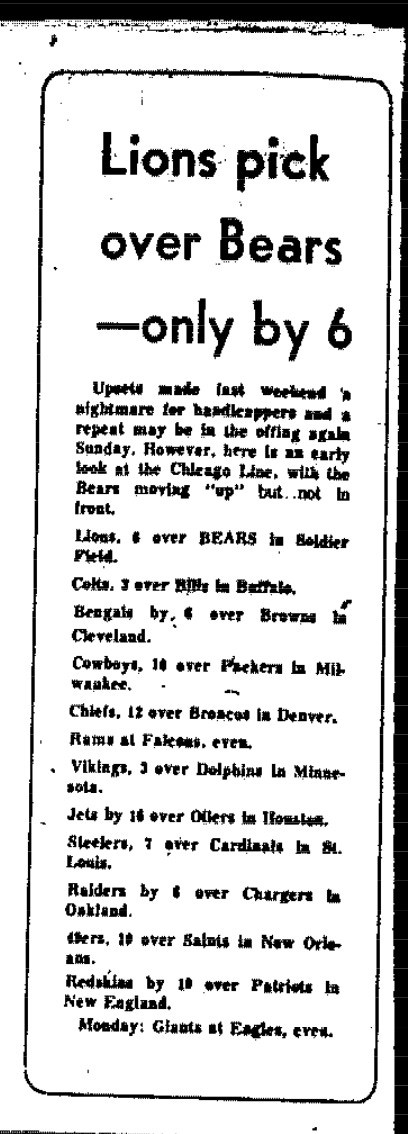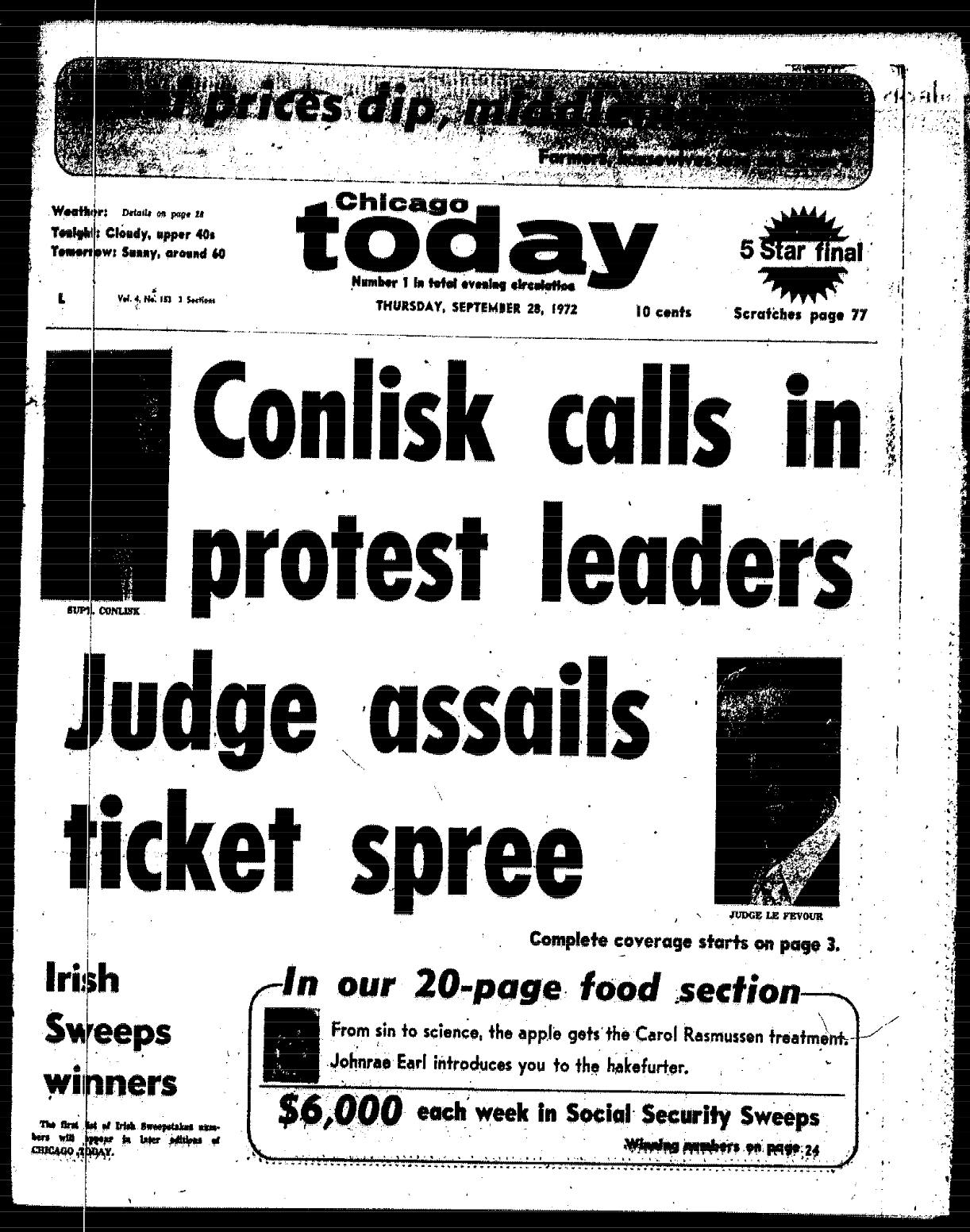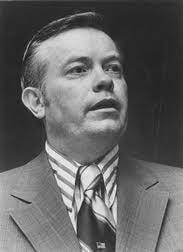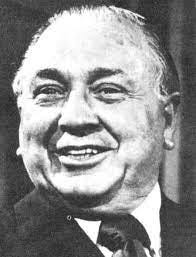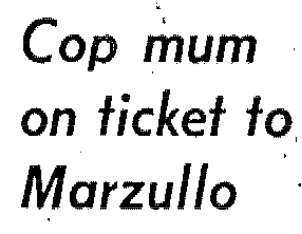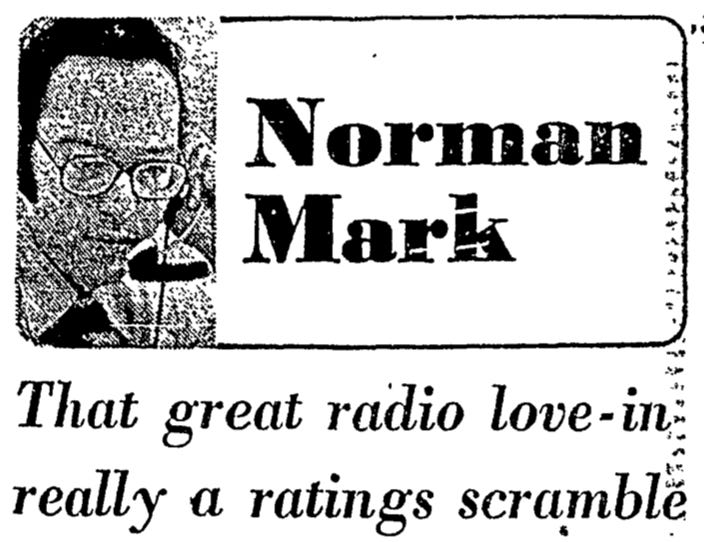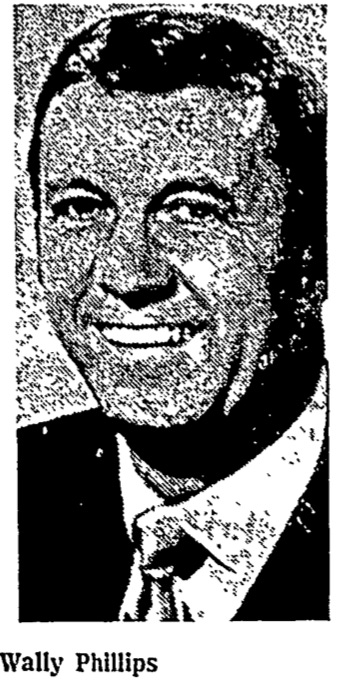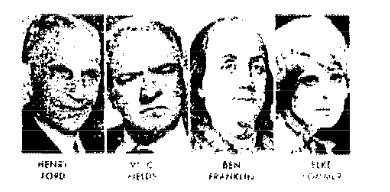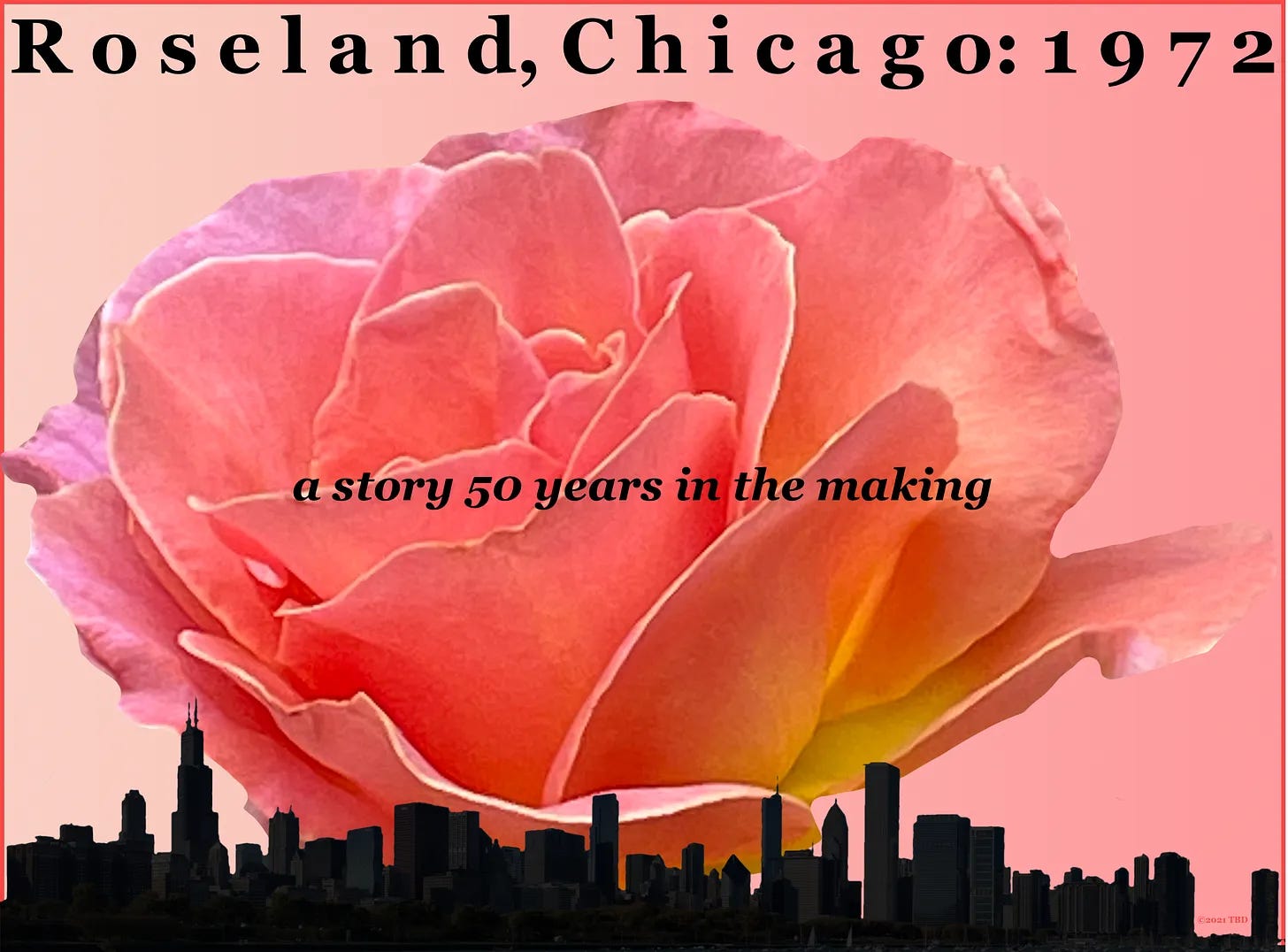To access all website contents, click HERE.
Why do we run this separate item peeking into newspapers from 1972? Because 1972 is part of the ancient times when everybody read a paper. Everybody, everybody, everybody. Even kids. So Steve Bertolucci, the 10-year-old hero of the novel serialized at this Substack, read the paper too—sometimes just to have something to do. These are some of the stories he read. Follow THIS CRAZY DAY on Twitter: @RoselandChi1972.
September 25, 1972
Chicago Today: Bears
by Ed Stone
The Bears barely managed to tie the Rams yesterday 13-13, thanks to the defense—but in fairness to the Bears, the Rams were “heavily favored.”
The defense was the Bears’ “meal ticket,” writes Ed Stone, “and the offense, as Abe Gibron put it, ‘staggered.’”
“It was first down for Los Angeles at the Bears’ 43. Just over two minutes remained, plenty of time for the Rams to drive close enough for a good shot at a winning field goal,” Stone recounts.
Next “to Line was Willie Holman, who had stayed in all the way despite a damaged shoulder. It seemed the Rams would hit that side again. Instead, [Jim] Bertlesen started to sweep the other way. He never got out of the backfield. Ross Brupbacher blitzed and decked him for an 8-yard loss.”
Brupbacher, postgame: “Dick [Butkus] automaticked that call at the line. We are going with red-dogs because we had to get them out of field goal range. The only way to do it was to throw somebody for a loss.”
The Rams went on to gain 13 yards on a screen pass, “But on third and five, Garry Lyle, Butkus, and [Doug] Buffone smothered Willie Ellison for a one-yard loss.
“Butkus quickly called a timeout ‘to put a little heat on [David] Ray,’ hoping the Rams field goal man would get nervous waiting for his chance from 47 yards out. Nervous or not, Ray was far enough away so that his kick faded to the right.” “It missed by that much,” Buffone said later, “holding his finger two inches apart.”
Elsewhere, “For a change, Bobby Douglass wasn’t the worst quarterback on the field.” That’s because the Rams’ Roman Gabriel had “a lame arm,” so they had to go with Pete Beathard, “and he was awful.”
Douglass actually threw “a perfect 36-yard touchdown pass to Earl Thomas in the fourth period after the Soldier Field crowd had tried to hoot him out of the game.”
“One thing about this guy,” Stone writes of Douglass, “it’s impossible to demoralize him. He has a powerful ego to sustain him while everything is going wrong.”
Chicago Daily News
Chicago Daily News: Gale Sayers column
Bears star Gale Sayers was forced to retire before the season started due to his knees. Chicago is in mourning about that, but it’s been coming for two years, so not a shock.
Now, Sayers is writing a weekly column for the Daily News. If you think Gale Sayers is too nice for this gig, I believe you are correct. At least his column is better than the dreck Joe Pepitone was pumping out all summer. But compare Gale’s observations with Chicago Today’s Ed Stone’s in the item above.
“The Bear linebackers showed Sunday why they are among the best in the National Football League,” Sayers opens.
“Dick Butkus, Doug Buffone and Ross Brupbacher did a tremendous job in the tie with Los Angeles. If it weren’t for those linebackers, we’d really have been in trouble because the Rams came to town with a terrific running attack and the Bears defensive line was hurting.”
….. “I really can’t say much for our offense. Bobby Douglass’ passing was not so good, only three completions in 15 attempts. But Bobby had a good day running….Abe should have let Bobby run it 30 times. Bobby ran it seven times for an average of 11.7. yards. He was really running with determination and drive. He’ll do anything to prove he can play quarterback.” Anything except…throw well.
Sayers concedes that the Rams offense was already off because Roman Gabriel didn’t start. But, he concludes, “our linebackers upset it a whole lot more. I can’t say enough about the heckuva fine game they played.”
Nothing there will get Gale Sayers in trouble with anyone, even the Rams.
September 25, 1972
Chicago Today: WBBM ad
The current ad campaign for WBBM struck me as an early harbinger of online newspaper websites, and the disappearance of physical newspapers. It’s not what they meant at all, of course.
September 25, 1972
Chicago Tribune: Letter re Kiyo Japanese Restaurant
The letter below was also printed in the Defender and the Daily News. I may have missed it in the Sun-Times since I didn’t get that paper on microfilm for this week.
James Hammonds, co-director of the Preventative Legal Services Program, writes to object to the method used by two police officers to end a high-speed chase across the city, after a robbery-hostage situation at Kiyo Japanese Restaurant that captivated the city. One cop shot the driver of the robbers’ car speeding on the Dan Ryan with five hostages. Yes, it happened—and at the time, nobody suggested it was nuts. At least, not in the papers. This is the first objection I’ve seen, insisting the police should rethink their strategies.
If you missed it, see August 30 for the initial robbery and hostage situation at Kiyo’s Japanese Restaurant, where the drama started, and August 31 for some fascinating follow-ups.
September 25, 1972
Chicago Tribune: Willie Lee Browner
by Harold Remy
Police have been staking out payphones on Lake Shore Drive since April 15, when two gunmen robbed William Jones of $4,900 as he used the payphone at 43rd Street. There have been at least several other LSD payphone robberies as well.
Younger Readers: They’re gone in 2022, I believe, but there used to be several payphones on small shoulder cut-outs on Lake Shore Drive, both north and south. Remember, it’s B.C. —Before Cell phones.
Last night, officers Pete Jonites and John Brennan were hiding in the bushes near the 43rd St. pay phone when Fred Hoard pulled over to make a call.
Hoard said he was using the phone while sitting in the car’s passenger seat when 18-year-old Willie Browner walked up and demanded money. “He gave the gunman $6 in a money clip,” writes the Trib’s Harold Remy, “and Browner said, ‘Now give me the real money out of your wallet.’”
“I said I had none, and he fired at me,” Hoard is quoted. “I leaned back in my seat. I could feel the bullet go past my head. I can still smell it.”
Prairie Avenue District Commander Capt. James O’Grady said that as Browner fired, officers Jonites and Brennan “were rushing toward Hoard’s auto with their guns drawn. They shouted that they were policemen. As Browner turned, they fired two shots into his body killing him, O’Grady said.”
Chicago Daily News: Willie Lee Browner
The Daily News reports that the Lake Shore Drive phone stake-outs followed “a wave of more than 100 robberies”.
Officer John Brennan said he saw Willie Browner emerging from a bushy area moments after Fred Hoard drove up to the phone. Browner approached the auto and stuck a .38 caliber revolver through the window, Brennan said.
“The two officers said they moved out of their hiding places in the bushes after hearing Browner fire a shot. Brennan said that when he identified himself as a policeman, Browner ran toward the Illinois Central tracks west of the Drive. Brennan said he fired three shots with his pistol. But Jonites, who was closer to Browner, gunned him down with a shotgun blast.”
“Police found Hoard’s wallet and money clip containing $6 on Browner’s body.”
Browner, 18, of 4155 S. Lake Park, died later at Michael Reese Hospital.

September 26, 1972
Chicago Defender: Willie Lee Browner
by Joe Ellis
Willie Lee Browner’s mother “bitterly criticized” the police account of her son’s death during an attempted robbery at the payphone at 43rd and Lake Shore Drive, on the southbound (west) side of the drive.
Mrs. Susie Browner “stopping short of calling her son the victim of an ambush.” “If he was running from one officer into the arms of another one, then I don’t think they had to shoot him like they did,” she said. “He can’t talk for himself and there’s no telling what really happened.”
Fred Hoard, 50, of 9423 S. Michigan, gave Browner his money clip with $6. When Browner demanded more money and his wallet, Hoard said he didn’t have any. Browner shot into the car, but hit the window frame. Hoard then handed over his wallet.
Officers Peter Jonites and John Brennan had exited a hidden squad car between Hoard and the Illinois Central train tracks west of Lake Shore Drive.
“Brennan, who said he was behind the suspect, yelled out ‘Freeze! Police!’ He said Browner started to run towards where Jonites was hidden. Jonites fired his shotgun, hitting Browner, who apparently never saw him, in the chest. Brennan said he fired three shots at the suspect, striking Browner at least once in the left thigh.”
Willie Lee Browner had dropped out of high school. Mrs. Browner said he was learning house painting in “a welfare department-sponsored course.”
“Police records revealed that Browner was convicted previously of theft on June 26th of this year, and given one year’s probation. He was also arrested for battery on May 27 and again on Aug.18 of this year. Both of these charges were dismissed.”
Browner’s funeral was planned for the A.A. Rayner Funeral Home on Cottage Grove. He was also survived by three brothers and four sisters.
September 26, 1972
Chicago Today: WBBM ads
September 26, 1972
Ticketpalooza begins
The afternoon papers get the first bite out of this delicious story.
Four crack Chicago Today reporters at once! Mmm-mmm good.
“Thousands of angry Chicago policemen are engaged in a ticket-writing campaign aimed at snarling the city’s rush-hour traffic and forcing the police administration to meet their demands for job improvement.”
Why wouldn’t these gripes go through the police union? Because there isn’t one yet in 1972, and that’s one of the main things the police want—a recognized bargaining unit.
At this time, there are several police groups, but none are a union. I know, how weird is that.
Per Today, the “militant” Confederation of Police, or “COP” is the largest group, with 8,000 members out of the current 14,000 cops. The Chicago Patrolman’s Association has 4,000 members, and there are also the Fraternal Order of Police and the Afro-American Patrolmen’s League. FYI, Chicago Today uses periods in these acronyms, the Daily News doesn’t. I’m going with the News style.
Today says COP is behind this, and CPA supports it. But Chicago Today can’t get an answer on C.O.P. President James M. Johnson’s phone— “a phone company verifying operator said his phone was off the hook.” That’s the 1972 equivalent of putting your smart phone on airplane mode.
“The protest, which began at midnight Sunday, was announced in circulars distributed to the men and apparently grew out of a stormy rally of 3,000 policemen on Sept. 17.”
That rally, run by COP, produced a list of 20 demands to Police Supt. James Conlisk. Police demands included establishing an actual procedure to solve cop grievances; “the abolition of one-man squad cars, the formulation of a ‘Policeman’s Bill of Rights,’ and restoration of step pay raises denied by the city last year.”
BTW, the police aren’t just putting parking tickets on windshield, though they are doing that too. But mainly, they’re stopping people for moving violations. 1972 cops, we learn, normally average two moving violation tickets per day. One of the circulars called Sept. 25-30 “Cop Enforcement Week” and exhorted cops to write ten tickets per shift.
“Starting at midnight on Sunday and continuing for five days every man will write ten tickets a day for any violation he sees,” reads the circular—below. “This will entail stopping newspaper trucks, telephone, gas and electric company trucks, and anybody else who has even the least violation.”
Target time period for maximum tickets: rush hour.
If this doesn’t get the cops what they want, next week will be “Job Action No. 2,” when the cops won’t write any tickets at all.
Out of 21 police districts, tickets are reportedly up 50% in at least eight districts, and significantly in three more. “Some reports said ticket writing was so heavy that watch commanders in some districts were forced to lock up fresh ticket books,’ per Today. But officials deny it.
An anonymous protest leader tells Today that cops are spending as much time as they can filling out “contact cards,” a routine piece of paperwork about anyone stopped outside assigned investigations. “We are taking up a lot of time with picayune things,” he says. “That is the purpose. Yet by filling out those forms, no one can say we weren’t on the job.”
It’s a “blue flue” without missing work.
“We are showing the top police officials our power, our unity and our determination to get at least one police organization recognized as a bargaining agent so we can get contracts like everyone else.”
The Daily News gets hold of COP president James Johnson, who denies that COP has anything to do with the tickets. He calls it “a wildcat action”—though he says Supt. Conlisk can end it by addressing the COP reform demands.
Did you know the heart of “Roseland, Chicago: 1972” is the story of Steve Bertolucci, 10-year-old Roselander in 1972? His story starts here.
September 26, 1972
Chicago Today: Skyway
Some things never change.
September 26, 1972
Chicago Today: Wishing Well
Chicago Today prints this Wishing Well game randomly, as far as I can see, smooshed in between other small items toward the back of the paper. If anyone wants to try it, let us know how it goes!
September 26, 1972
Chicago Daily Defender: Letter to the editor
Reader F.J.J. voices one prevailing theory of Mayor Daley’s motives in reconciling with Democratic presidential candidate Sen. George McGovern, even though McGovern let Daley and his Cook County delegates to the Democratic National Convention get kicked out and replaced by independent delegates organized by Ald. Bill Singer and Rev. Jesse Jackson.
Channel 5 News’ Walter Jacobson, who does on-air commentaries, is one who suggested this theory—that Mayor Daley is promoting a straight Democrat ticket in order to re-elect incumbent State’s Attorney Ed Hanrahan, without personally backing the controversial Hanrahan.
Recall that Hanrahan is currently on trial for conspiracy to obstruct the investigation of his office’s pre-dawn police raid on a Black Panther apartment that killed Panthers Mark Clark and Fred Hampton.
Did you miss TCD1972’s coverage of the coverage of the 1972 Democratic National Convention—when Mayor Daley and his delegates got kicked out? It’s waiting for you right here.
September 26-27, 1972
Chicago Daily News: Butkus and Lions
by Ray Sons, Sports Editor
Next up on the Bears schedule: the Detroit Lions.
“You can bet that the Detroit Lions have turned literary critics this week, as they await Sunday’s game with the Bears in Soldier Field,” writes Ray Sons.
“And the best seller in their dressing room will be: ‘Stop-Action,’ the new book by Dick Butkus and Robert W. Billings.”
What will the Lions read about themselves in Dick Butkus’ new book?
“I think they are a lot of jerks, from the owner, the general manager, the coach on down. Even the announcers must be a bunch of fags. If we were voting for a jerk team or organization they’d have my vote all the way.”
Note: The term ‘fag’ was not an unusual word for 1972 men to use as a general insult. This is unfortunate, but true. In this context, “fag” wasn’t meant literally as a slang term for “homosexual man.” Instead, it’s a stand-in for words like “weak” or “lame” — just like insulting words that literally mean “woman” or “vagina,” such as “pussy.”
It’s been a while since I read “Stop-Action” cover-to-cover, but my recollection is that “fag” is not used repeatedly. It’s “jerk” that is the big go-to insult throughout.
Why these kinds of words? Why not “asshole” or “shithead” or whatever? Because in 1972, profanity would never have been allowed in a book the publisher hoped to sell to a general audience. This is the year George Carlin got in trouble for swearing and subsequently created a famous comic routine about it, “Seven Words You Can Never Say On TV.” In contrast, “fag” wasn’t considered a strong term. You can tell since it’s printed in the newspaper.
I mention this for Younger Readers, who might otherwise assume Dick Butkus was violently homophobic for using that word. I can’t look into his heart, but there’s nothing else in the book to indicate that. The use of that word alone, in 1972, does not indicate violent homophobia, as offensive as it is in 2022. In this context, with no other indicators, using the word “fag” only suggests the widespread ignorance of the time.
I could have avoided this whole discussion by abbreviating the “Stop-Action” quote Ray Sons chose to use, but as noted in the About page, you enter 1972 at your own risk. The point of looking at the 1972 world here is not to clean it up.
Butkus also describes how much he enjoyed watching the Lions lose to the Vikings last season, notes Ray Sons, calling out Lions middle linebacker Mike Lucci and center Ed Flanagan.
Lucci “is regarded in Detroit precincts as a Butkus equal, an appraisal in which Butkus does not concur,” writes Sons. “Ed Flanagan is the star Detroit center who often will draw the assignment of trying to block Butkus.”
“After Flanagan reads the Butkus book,” writes Sons, “this bout ought to be even more memorable.”
Chicago Today
by Ed Stone
Ed Stone concurs with Ray Sons, of course.
“No other Bear opponent has done as good a job of earning Dick’s contempt as the Lions,” writes Stone. “As Butkus told [co-author Daily News reporter Robert] Billings:
‘I’m damn sick of this whole Detroit situation. For the last couple of years now this Lucci has been trying to make some sort of reputation for himself by knocking me. I wish to hell he would try to make the Pro Bowl on the field instead of with his mouth.
‘No one but those jerks has ever called me a dirty player….They started this thing, Joe Schmidt popping off about Lucci, how great he is….It annoys me when someone says that anyone is as good or better than me. Call it ego if you want, but it just isn’t true….I’ve seen Lucci get run right off the field.’”
Re Flanagan, Stone uses this Butkus “Stop-Action” quote:
“Flanagan’s always crying that I swear at him, the poor little fellow. Well, when someone’s holding me, I don’t just say, hey, please don’t hold me now. I say the first thing that pops out of my mouth, and it’s usually some reference to his birth or training.”
Ed Stone has checked the Detroit papers, which printed some choice responses from the Lions.
“‘I didn’t know he could write,’ commented Lucci. ‘We must be hassling him if he’s got to write that stuff. It’s horse bleep.”
Lucci didn’t say “bleep,” but in 1972, as discussed above, you would never read the word “shit” in your afternoon (or morning) newspaper.
September 27, 1972
Chicago Daily News: Martha Mitchell
September 27, 1972
Ticketpalooza Day Two
by John O’Brien
At a press conference, COP President James Johnson and CPA President Joseph Pecoraro still insist the police ticket-writing spree is totally spontaneous—but it’ll stop if Police Supt. James Conlisk agrees to a police contract “with binding arbitration and grievance procedures”.
Pecoraro said Chicago is the only big city without a police union: “I am only glad they [police] accepted this job action and did not do what some had in mind—strike.”
“Informed by the Tribune of the Johnson-Pecoraro statement, Conlisk replied, ‘If they want an appointment, they know where I am.’”
“Prime targets of the ticket writing appeared to be the Chicago Transit Authority buses, trucks, including newspaper circulation vehicles, and motorists in the Rush Street and New Town nightlife areas on the North Side.” That includes 40 tickets for buses alone. New Town is the neighborhood called Lakeview in 2022.
by Jeff Lyon
As cops keep up the ticket blitz, #2 police official First Deputy Supt. James Rochford tells Chicago Today:
“If we find officers doing anything we deem to be official misconduct, they will be arrested and prosecuted. If it borders on department infraction, we will seek suspension.”
Rochford says individuals involved “are being identified.” Speaking for Supt. Conlisk, Rochford insists “there is no chance the department will give in because of this action.”
“The Foster Avenue station during the second shift recorded the issuance of 300 ticket by its men compared with a normal 30,” notes Lyon. “About 400 tickets were turned out by the Town Hall District men when 50 would have been a good night.”
That’s unofficial, since the officials won’t release official numbers yet.
In a separate piece, we learn that Today is hearing cops are suddenly being required to report how many tickets they issue on a signed form. “One thing is for sure, the writing spree is hurting somebody real bad or the heat wouldn’t be on,” says an anonymous cop.
Rochford predicts the cops will stop soon, because they started out with the “false courage” of numbers.
We’ll see! Per Jeff Lyon:
“A reporter walked two blocks to dinner and saw a squad car in the 18th District pull over a cab at St. Clair and Ohio Streets and make both driver and passenger sit in his car.
“A lieutenant, obviously checking out the validity of tickets, pulled up in a one-man car. He questioned the policeman, shook his head and drove on.
“Almost immediately another squad car appeared, with its driver spinning his head around in apparent search for violators.”
The proof is literally in the courts:
Supervising Traffic Court Judge Richard LeFevour says: “The prisoner call was tremendous. When I looked at the list they gave me in the morning I couldn’t believe it. On Tuesday we ordinarily have 30 to 40 prisoners but here were 100 locked up just for failure to have $25 to post bond.”
That’s $168 in 2022 money.
“They were really minor violations,” Judge LeFevour added.
This Green Streak Today cover is a little over the top. Nothing was burning.
That’s right, Mike is all over the ticket blitz. Check out this week’s Mike Royko 50 Years Ago Today, posting Tuesday.
The Daily News’ Phil Blake reports on the front page that rumors are circulating “throughout the 12,000-member department” that after the ticket spree, the next step will be responding to only emergency calls.
Note: Later news accounts will adjust the number of police to 13,500.
All this “as the flashing blue lights of squad cars became a common sight for motorists and yellow parking tickets fluttered from the windshields of thousands of cars.”
COP and CPA officials still insist they didn’t start the action, but “policemen participating in the campaign said it had been started to back COP and CPA demands for job improvements and changes in department policies.”
No direct comment from Supt. James Conlisk.
But plenty of comment from Ald. Vito Marzullo, see below.
Tribune and Daily News: Marzullo
“Ald. Vito Marzullo [25th], colorful veteran of 53 years in Chicago politics, came storming into the City Hall press room yesterday morning,” writes the Trib’s Edward Schrieber.
“Waving his arms in the air, Marzullo, 74, bellowed: ‘I got a parking ticket!’”
Marzullo got a parking ticket—they were yellow at that time—on his big black Cadillac, in front of his home at 832 S. Oakley Blvd. It was a ticket for parking too close to a fire hydrant. Marzullo insisted that he paced the distance between the hydrant and his Cadillac, and it was farther than the legally mandated 15 feet.
“‘What are they trying to prove?’ Marzullo exclaimed,” writes the News’ Jay McMullen. “‘Why don’t they go out and devote their time and energy to fighting crime and drug and dope peddlers?’ he asked.”
Ald. Marzullo claims he’s always supported police, but now he’s not so sure. And as McMullen notes, Marzullo is on the City Council Finance Committee, “which will consider police and fire pay demands next month.”

September 27, 1972
Chicago Daily News: Montgomery Ward
September 27, 1972
Chicago Today: editorial, Montgomery Ward
September 27, 1972
Chicago Today
Get your bets in.
September 27, 1972
Chicago Defender: S & H Green Stamps full page ad
September 27, 1972
Chicago Defender: Johnnie Warnsley
by Joe Ellis
“Johnnie Warnsley, 16, lies in a coma and was listed in critical condition Tuesday at Little Company of Mary Hospital, suffering from extensive brain damage and severe concussion inflicted when he and five friends were attacked and beaten by a gang of white youths last Saturday at the Pizza Hut, 9730 S. Western ave., in the Evergreen Plaza shopping center.”
Hospital officials don’t expect Johnnie to live. Initially, after x-rays, he was sent home home from the hospital. But later, he began vomiting and complained of head pain. His parents brought him back to the hospital. Doctors operated Monday night to relieve pressure on Johnnie’s brain, but his condition hasn’t improved.
Johnnie, of 9535 S. Bishop, went to the Pizza Hut Saturday afternoon with five friends. They bought pop, put money in the jukebox, and sat down at a table.
Reportedly, a waiter asked them to leave, and they refused. The waiter reportedly returned with the assistant manager, Joe O’Brien, 18, who told Johnnie and his friends that the tables were for customers who ordered pizza.
“The youths replied that they would [leave] after they finished their cokes and listened to the records they played on the jukebox.
“Witnesses told police that O’Brien then pulled the chair from under Johnnie, causing him to fall to the floor. Five other employees of the restaurant and four customers, all of them white youths, ranging in ages from 15 to 19, surrounded Johnnie and his friends and a fight erupted.
“O’Brien allegedly struck Johnnie repeatedly over the head with a chair while the other white youths, some of them drawing knives, attacked Johnnie’s friends at the table. The black teenagers reportedly managed to fight their way out of the restaurant, leaving Johnnie unconscious on the floor.”
Johnnie’s friend Calvin Cooks tried to drag Johnnie along, but was chased away.
“When police arrived, Cooks was screaming for help as the white youths beat him….Police handcuffed Cooks and put him in a squad car.”
Police brought Calvin Cooks and Johnnie to the hospital, where they were both treated and released. As we know, Johnnie relapsed later that night. O’Brien was arrested later by Oak Lawn State’s Attorney police for aggravated battery.
September 28, 1972
Chicago Tribune: Johnnie Warnsley
The Tribune repeats the basic facts of Johnnie’s case—the white Pizza Hut employees asked Johnnie and his friends to leave, stating that tables were “reserved for customers ordering pizza,” leading to the fight.
“Witnesses said [Joseph O’Brien] threw a heavy chair at Warnsley’s head during the fight.”
O’Brien, of 9945 S. Fairfield, was charged with aggravated assault and released on $10,000 bond with a court date of Oct. 25.
September 28, 1972
Chicago Daily News: Abe Gibron on Channel 2
September 28, 1972
Ticketpalooza Day 3
Chicago Today
no byline
Supervising Traffic Court Judge Richard LeFevour sounds a lot more ticked off today, calling the Chicago police ticket spree “public harassment” and “bad police public relations”.
“Despite increased pressure from high department officers, including assignment of ticketing champions to less desirable beats, a blizzard of yellow traffic citations still continued thru many police districts,” writes Today. “Also, in some districts policemen have been ordered to quit part time jobs.”
But Today somewhat buries the lede, because the main news here is that Police Supt. James Conlisk has finally “ordered the presidents of the patrolmen’s associations to a meeting today in his office at 1121 S. State St.”
More importantly, Mayor Daley has spoken: “If they are trying to threaten anyone, they are making a mistake.”
But Mayor Daley also “said his office is anxious to settle the dispute and suggested that some money be found in the 1973 budget for pay raises.”
Today notes that “Dissident officers say pay is not a central issue.” It’s the need for a bargaining union, a grievance procedure, and safety issues like one-man squad cars.
by Jeff Lyon and Michael Hirsley
“The stout police officer jumped from the curb into the path of two cars, his arms flailing,” Lyon and Hirsley open. “A little book of yellow blanks was in one hand and a pen in the other.
“He managed to halt the autos before they crunched him, and then proceeded to write moving violation tickets for both.”
His partner was doing the same thing a half block away with some other cars.
“The daring pair exemplified the determination of many policemen to continue to ‘paper’ the city despite departmental reprisals that have begun with making men leave their squad cars and walk foot patrols.”
That order came down yesterday in the Foster Avenue district, particularly hard hit by the ticket spree. In another hard-hit district, East Chicago Avenue, “protest-quashing measures extended to sending four squad men to new beats—walking in the highly volatile Cabrini-Green project,” where they had no experience.
One policemen who “hurled himself into the street to get someone with a defective headlamp” wrote a ticket, then spoke to Today “with a Cheshire grin on his face.”
“Writing extra tickets? Naw. Walking the street because we wrote too many? Not so. This is part of our regular walking tour out here.”
But then his partner came running up looking for more blank tickets.
“His cover blown, the grinner opened up a bit.
“‘No, I’m writing tickets all right. And a lot of other guys on foot are doing it, too, not because we like it. But we’ve been knocking on the superintendent’s door for two years and he won’t listen.”
Chicago Daily Defender
And let’s not forget the editorials.
Sadly, I’m missing this week’s Sun-Times. I’ll go back to check their ticket coverage and slip it in when I have time. Meanwhile, let the other three major dailies rip, all on the same day:
Chicago Today doesn’t know if the ticket spree will get police their demands, but they do know this:
“It has irritated or enraged thousands of normally peaceable citizens, and directed their anger at the policemen, not at the department. It has shown that the ticket-writers regard law as a kind of handy all-purpose mechanism which they are free to operate for their own purposes. It has pretty well blown apart the image of pride and integrity that the police try hard to build up—and in which a lot of policemen’s lives have been invested.”
Today says the editorial “is not an attack on their demands,” which “might be just what the department needs.”
The Daily News calls the whole thing “the dumbest” scenario “since the Keystone Kops.”
“The motorist tagged for a trifling error in traffic—or for such things as a just-blown tail light—isn’t going to gush tears of sympathy for the man with the badge. He’s going to be mad. Not at City Hall. At the cops.”
The Daily News notes that the 20 police demands include “releasing policemen from the requirement that they take lie detector tests and testify (instead of taking the Fifth Amendment) when accused of wrongdoing. Both department rules are essential to the prevention and cure of corruption in the force, and the average citizen must conclude that the ends in this case are no more valid than the means.”
The Tribune notes that one cop who usually writes five tickets per day “distinguished himself by catching no fewer than 72 motorists in the act of committing such horrible crimes as driving without a light on the rear license plate.”
But the Trib takes a surprisingly lenient approach compared to the Daily News:
“We’re not at all sure that the present form of protest is the best way to win the hearts of the public, but we must acknowledge that it is an ingenuous one.”
The Trib points out that the police will have to be “equally understanding when it comes to the enforcement of the laws and rules affecting policemen who refuse to answer calls for assistance or who go out on strike. We mention these because they are what many of the dissident policemen are threatening to do next.”
September 28, 1972
Chicago Tribune: Bernard Carey
by Robert Endstad
Bernard Carey, former FBI agent and the Republican candidate for State’s Attorney, told the B’nai B’rith Justice Lodge that police shouldn’t be allowed to shoot at fleeing suspects.
This week, that may apply to Willie Lee Browner, the 18-year-old who robbed and shot at a man using a payphone at 43rd and Lake Shore Drive earlier this week. Browner was shot by police immediately afterward. I say “may” because description of events in the Browner case weren’t specific enough to be clear on whether Browner was running with his gun in his hand and posed a real threat to the officers. But you’d think the police would mention a gun in the hand of suspect, if that were the case.
Recall that Carey is running against incumbent Edward Hanrahan, who’s currently on trial for conspiracy to obstruct justice in the killing of Black Panthers Mark Clark and Fred Hampton in a 1969 predawn raid by police assigned office.
“We were taught [in the FBI academy] that if he [the suspect] gets away that you will get him again,” Carey said. “FBI men cannot even fire warning shots.”
The Tribune endorses Carey for State’s Attorney this week, joining Chicago Today, the Daily News, and the Defender—almost surely the Sun-Times too, but I’ve missed a week here and there of the Sun-Times and can’t access its data base for 1972. Republican Carey has also been backed by Democratic Black officials Aldermen Anna Langford and William Cousins, and U.S. Rep. Ralph Metcalfe.
September 28, 1972
Chicago Defender: The Brown family
by Robert McClory
“Black homeowners and realtors are getting the message that ‘the heat is on’ in the fashionable Southside Beverly neighborhood the Daily Defender learned Wednesday,” writes Robert McClory.
“Officials of the state Department of Registration and Education, acting without authorization, have urged real estate agents to lay off the area. And a home recently sold by one broker to a black family was attacked Tuesday night, resulting in the destruction of the owner’s automobile.”
The Brown family moved into 11756 S. Longwood on Sept. 1, and on Sept. 26, Maurice Brown “found his 1972 Pinto, parked in the driveway, engulfed in flames about 9:30 p.m. The car, apparently a total loss, was hauled away after firemen extinguished the flames. Brown said ample evidence of a Molotov cocktail was found nearby.”
Brown said a firebomb was thrown on his porch the day after he moved in, but didn’t ignite.
Brown bought the $40,000 home from Bruce Owens of the “black-owned company” of Owens Bros. Realtors.
Owens tells the Defender he was visited recently by officials from the registration department, “which approves and revokes realty licenses.”
“They asked me as a favor to refuse to do any business in Beverly. They said letters are being sent to the mayor and governor about racial change in the community and told me the heat is really on.”
Owens, who said he doesn’t solicit in Beverly, called the visit “a polite form of intimidation” and said the state had no right to restrict his business.
Marion Maner of Maner Realty also got a visit from the registration department, and said he does solicit business in Beverly, and he’ll keep doing it. In this context, “soliciting” means contacting home owners and asking them if they want to sell. “He denied, however, that he was involved in panic peddling, or block busting, since his salesmen studiously avoid those homeowners who have registered with the city as not wanting to sell.”
“‘Black families who have achieved some economic stability have a right to move to better neighborhoods,’ he said, ‘and Beverly represents an attractive neighborhood.’”
William H. Robinson, the state registration department director, admitted that some of his people had visited the real estate agents, but without his knowledge, and that they’d “be looking for other employment” if they did it again.
Robinson tells McClory that his people were responding to complaints from the Beverly Planning Association (BPA), but that complaints about panic peddling must first go to the city or state Department of Human Resources.
“However, Phillip Dolan, executive director of the Beverly Planning Association, said, ‘Robinson is wrong when he states it is not within his jurisdiction to investigate complaints or warn realtors. The licensing department should seriously probe panic peddling and real estate exploiters, white or black.”
Dolan “said his association has almost eliminated blockbuster solicitation from Beverly by ‘persuading brokers to stay out. He agreed that solicitation could not be legally forbidden, but said most realtors had been ‘convinced’ to work elsewhere nonetheless.
“Realtors like Owens, he said, create a ‘moral disturbance and do no good for themselves or their clients. Unless we take a stand here, the city of Chicago will become a refuge for the old, the poor, and the black.’”
Oddly, there’s no trace of the Brown family’s firebombing in the Tribune or Daily News archives, and I didn’t see it in Chicago Today. I wasn’t able to get the last week of September for the Sun-Times.
It’s strange, since all the major dailies have covered the spiraling issue of violence against Black families moving into formerly all-white South and West Side neighborhoods, and the vicious cycle that then results in white crime victims in changing neighborhoods.
The Tribune’s Cornelia Honchar covered this in two parts, “No Welcome Mat Out When Blacks Move In” on July 9 and “Why Whites Leave” on July 10. Chicago Today examined the general issue on June 4.
See May 25, May 26, May 27, and May 28 in TCD1972 for coverage of attacks on the Jordans and Mapps in West Pullman/greater Roseland, and the Harpers in Beverly, and July 10 for the Drapers in Gresham.
For white crime/attack victims, see the murder of Kathleen Fiene, June 21 and June 22; the shooting of Melba Winston, June 23; the attack on Peter La Rocca in Palmer Park on Aug. 4; the home invasion that left 12-year-old Joseph O’Shea in a brief coma, July 28, July 29, July 30, Aug. 2, Aug. 4, Aug. 6 and Aug. 7; and the murder of Helen Lyons, coverage Aug. 21-22.
September 29, 1972
Chicago Sun-Times: Marjoe ad
I’ve run out of space again. Marjoe may have to get his own special edition. Among the writers reviewing him: Roger Ebert and Bruce Vilanch. Oh yes; a special edition will come.
September 29, 1972
Chicago Tribune: Johnnie Warnsley dies
Johnnie Warnsley died Sept. 28 from the injuries he sustained in the fight at the Evergreen Plaza Pizza Hut on Saturday. Johnnie and his friends were reportedly attacked by a group of white youths including assistant manager Joseph O’Brien, 18, the assistant manager, who reportedly “threw a heavy chair at Warnsley’s head.”
September 30, 1972
Chicago Defender: Johnnie Warsnley dies
Johnnie Warnsley was a sophomore at Morgan Park High School. He died of “massive brain damage” from the concussion he suffered during the Pizza Hut fight with a group of white youths on Saturday at the Evergreen Plaza Shopping Center.
“While his parents and family were sadly putting together their plans for his funeral, Maurice Helen, assistant state’s attorney for Oak Park, said it may take two more days of questioning witnesses before a decision to place murder or manslaughter against” Joseph O’Brien.
Oddly, this account says Evergreen Park police “refused to divulge” O’Brien’s address, but it’s already been printed in the Tribune—9945 S. Fairfield.
“O’Brien, one of 10 white youths who was questioned after witnesses, mostly black, complained the shopping center’s white guards stood by and did nothing except ‘throw around’ Warnsley’s companions”.
“Evergreen Park police said the disturbance at the Pizza Hut started when Warnsley and five friends went there Saturday afternoon for soft drinks.” The Pizza Hut is “a hang-out for local white teenagers (a fact which was unknown to the black youths)”. A waiter “walked up to them and asked them to order food or leave.” But “Nick Kosick, the manager, told the Daily Defender that there isn’t any policy requiring customers to order food before being seated.”
After Warnsley and his friends asked to listen to their jukebox picks, the same song played twice. Then the waiter left and returned with assistant manager O’Brien. After O’Brien told the friends to leave, “Warnsley moved his chair to stand up” and “O’Brien reportedly snatched the seat away and the fight began.”
“Both groups accused the other of pulling knives, although police said they did not confiscate any weapons.”
September 30, 1972
Ticketpalooza Day 4
Chicago Tribune
by John O’Brien and Frank Haramija
Chicago Daily News
The police ticket blitz apparently ended Friday.
“Police Department statistics for the 24-hour period ending at 8 a.m. yesterday showed the number of tickets issued down 1,500 from the comparable 24-hour period of 3,500,” per the Trib, with a peak on Wednesday of 4,100 tickets.
But one unfortunate participating cop left a yellow dropping on one of Mayor Daley’s unmarked police detail cars for his bodyguards.
“Shortly after the policeman, who is assigned to the Central District, hung the ticket on the mayor’s tail car, he was transferred from a squad car assignment to walking a beat in the dimly lit alley behind police headquarters at 1121 S. State,” writes the News’ Edmund J. Rooney.
COP President James Johnson and CPA President Joseph Pecoraro plan to meet in private on Saturday with 100 cops to discuss strategy. Meanwhile, they’ve “surprised observers by declaring all 20 points in the police ‘bill of rights’…open to ‘compromise and negotiation,’” per the Trib.
That comes “one day after [Police Supt. James] Conlisk warned late Thursday, at a meeting of all eight police organization elders….that he would order disciplinary measures. All of the leaders but Johnson told Conlisk they opposed the blitz.”
Pecoraro, head of the CPA, was “visibly shaken” as he left.
“But his voice rose in anger as he said all disciplinary action taken so far against the ticket writers must be stopped.”
September 30, 1972
Chicago Daily Defender: Mrs. Carol Stephen
by Earl Nelson
“A young Westside mother of two children and the community organization she co-founded have recently taken on the mammoth task of reforming the Austin area police forces in a drive to achieve better protection of area residents against a reported rising tide in crime and gang intimidation,” writes the Defender’s Earl Nelson.
“Mrs. Carol Stephen, 28, of 639 N. Latrobe ave., co-chairman of the Area 9 Council of the Organization for a Better Austin, a conglomeration of North Austin block clubs,” has met with local police officials and neighbors to get better police protection.
Mrs. Stephen especially wants “more and regular police foot patrols” and “heavier police guards at neighborhood schools.”
“The area is changing lately, more blacks are moving in,” says Mrs. Stephen, who is also Black. “One of the many crimes we’ve had to contend with was the rape of two young black girls at Howe Elementary School…These girls were 11 and 12 years old. The first girl was raped by five male students at the school and as far as I know these boys are still attending classes. The principal didn’t even do anything about it.”
“Another girl was shot and killed by gang youths at the school in June of this year. So far we haven’t heard anything about this from the police.”
Mrs. Stephen, her husband and some neighbors were robbed while sitting on their front porch in August. She says that when they got the name and address of the robber themselves, the police wouldn’t acknowledge their phone call.
“We can drive through the North Austin area anytime of the day or night and see these so-called foot patrolmen in restaurants drinking coffee or handing out traffic tickets,” Mrs. Stephen told the Defender, and she complained the police don’t enforce curfew laws.
“There are 8, 9, 10 year old kids walking the streets at 2 or 3 in the morning, breaking people’s windows and setting small fires,” she said, adding that a local gang called Yoko 4 is beginning to recruit in North Austin, going after kids as young as nine— “stopping the kids from attending school and extorting money from them. They also take money from neighborhood youngsters for allowing them to play in front of their own houses and if the kids don’t pay, the gang beats them up or breaks windows at their hones. They’re even selling dope to the children.”
Although it’s not mentioned, the Tribune reported on Sept. 26 that Mrs. Stephen’s Area Nine Council sponsored a meeting on Sept. 25 with police officials including Austin Capt. Charles Siedlecki and Deputy Chief John L. Cartan on Sept. 25. Three hundred Austin residents showed up at the YMCA at 501 N. Central Av. to complain about the exact issues Mrs. Stephen talks about in the Defender—the Logo 4 street gang, kids out after curfew, and lax police patrols.
“Howard Sanford, the new president of the Afro-American Patrolmen’s League, also attended the meeting,” Ronald Yates wrote in the Trib. “He told the crowd the police department is not responsive to the wishes of the people. He said police are pushed by their superiors to write tickets, not stop crime.
“‘Part of the problem in Austin is that most policemen are white and live in areas where blacks can’t or don’t live,’ he said.”
September 30, 1972
Chicago Daily Defender: The Brown family 9/30
by Robert McClory
The Beverly Planning Association’s all-white executive committee offered a $1,000 reward “for information leading to the arrest and conviction of firebombers or vandals who have been plaguing the racially changing community,” writes Robert McClory in the Defender.
This follows the firebombing of the Brown family’s 1972 Pinto in their driveway at 11756 S. Longwood.
“Phillip Dolan, executive director of the planning association, said his group is bound and determined to do ‘what no other community in Chicago has done. We are committed to salt and pepper integration. We intend to halt block by block black inundation.”
Dolan said BPA has persuaded most realtors to stop soliciting for sales in Beverly and Morgan Park, but “some black salesman, he said, have persisted, calling white homeowners as many as seven times in one night.” Per McClory, Dolan said the firebombings and vandalism “play directly into the hands” of the soliciting realtors.
Dolan wouldn’t say how BPA persuades realtors to stop soliciting, but said they don’t use vigilante tactics. “Even if we had,” he told McClory, “what other choice do we have against the forces exploiting our people?”
“He declared that the deeper villain is the state legislature, ‘which is controlled by real estate interests and permits realtor licenses to be retained by known panic peddlers.’”
October 1, 1972
Chicago Today: Trib/Today full page ad
October 1, 1972
Chicago Today: Marzullo ticket aftermath
The cop who left a ticket on Ald. Vito Marzullo’ s black Cadillac, allegedly parked too close to a fire hydrant in front of his home at 832 S. Oakley Blvd., appears “to be plagued with lockjaw,” according to a short unbylined article.
“No one wants to talk about the parking ticket issued to Ald. Vito Marzullo [25th[, a colorful veteran of 53 years in Chicago politics.”
Today has already identified the ticket writer as James Leyden of Traffic Area 4, but “Leyden isn’t talking.” Leyden says his commanding officer has ordered him not to talk, and his commanding officer won’t talk either.
“But Marzullo has had plenty to say, and he plans to say even more Nov. 3 when he has to appear in court.”
October 1, 1972
Chicago Today: Bill Melton Hydro-Jet
Anybody got an old Hydro-Jet laying around? Older Readers will no doubt remember not just these print ads, but the continual TV commercials on cheaper UHF stations and daytime TV in general.
October 1, 1972
Chicago Sun-Times: Wally Phillips column
Sun-Times
The introduction to Wally’s new column notes, as if everybody in Chicago doesn’t already know, that Wally Phillips is “king of morning radio in the Midwest” on WGN, AM 720.
But I can’t help but wonder if this new column has something to do with a recent piece by Daily News TV columnist Norman Mark, who wrote about the latest round of American Research Bureau ratings on Sept. 19.
Mark noted that WIND saw “the biggest increases”—double over the previous year—with its new format “alternating current hits with golden oldies”. But the “big loser was WGN-AM. During the week, more than 550,000 fewer people listened to WGN this year than last. By an odd coincidence, every quarter hour from 6 to 10 a.m.”—that’s Wally’s morning drive time slot— “WGN was down 52,000 people, while WIND was up 51,000.”
Wally is still #1 “by a wide margin,” and WGN is still “the big leader in many time periods,” wrote Mark, but “the station’s downhill slippage seems to be a trend. Other ratings service have noted it.”
Wally’s new column will be nice extra free publicity. Although the writing is basically a formula of sentence-sentence-corny joke, today’s column might surprise some listeners. I was surprised.
“This has nothing to do with political preference—I’m an independent anyway—but I’m glad the Sen. Tom Eagleton affair happened the way it did,” opens Wally in his debut. “It threw some light on the shadows of mental illness.”
Now that a public figure like Eagleton has “told the world” that he was hospitalized for mental illness, more people understand that mental illness, “like diabetes or a broken leg,” can be “arrested or repaired.” [See July 25, 28, 28, 29-30 and 30; and July 31 - August 2.]
“I have an idea of what he went through,” Wally writes. “I’ve been down that road as well. After coming to Chicago from Cincinnati, I found myself in the clutch of a severe depression. I didn’t seem to have any goals, or even values. So I consulted a psychiatrist and went into psychotherapy for two years.”
Wally says therapy worked for him, and “Life was no longer one big endurance contest….Now, the columnists call me the morning madcap, or WGN zany.”
It’s true. Those are the terms of choice in articles about Wally Phillips, and they’re not dismissive adjectives. In 1972, “zany” and “madcap” still retain their dictionary meanings—at least to readers over 30—rather than being words used only in sarcasm to mean the exact opposite.
But if you call him a nut, Wally says he’s OK with that too.
“I’m in good company,” he writes. The Sun-Times microfilm for this issue is almost illegible, but basically Wally mentions a bunch of famous people supposedly considered crazy for one reason or another.
“Perhaps there’s a very thin line between sanity and insanity,” writes Wally. “Didn’t some people say Bobby Fischer was bananas? Yet he’s a chess genius. And what about Paul Murphy, of New Orleans, who was the world’s first chess king before world championships were established? He would never play until he’d first eaten a large plate of shrimp. He said it was a special brain food that helped him, and I’m NOT making this up.”
If I’m reading this barely legible type correctly, Wally says that Ben Franklin would sometimes sleep in as many as [some big number] of beds each night. “He was convinced that insomnia was caused by wrinkled sheets.”
I can’t read the concluding paragraph, but I can tell it mentions Elizabeth Taylor and Howard Hughes. Howard Hughes is a human synonym for nuts, but I do wonder what Wally said about Elizabeth Taylor.
Did you dig spending time in 1972? If you came to THIS CRAZY DAY IN 1972 from social media, you may not know it’s part of the novel being serialized here, one chapter per month: “Roseland, Chicago: 1972” —FREE. It’s the story of Steve Bertolucci, 10-year-old Roselander in 1972, and what becomes of him. Check it out here.






